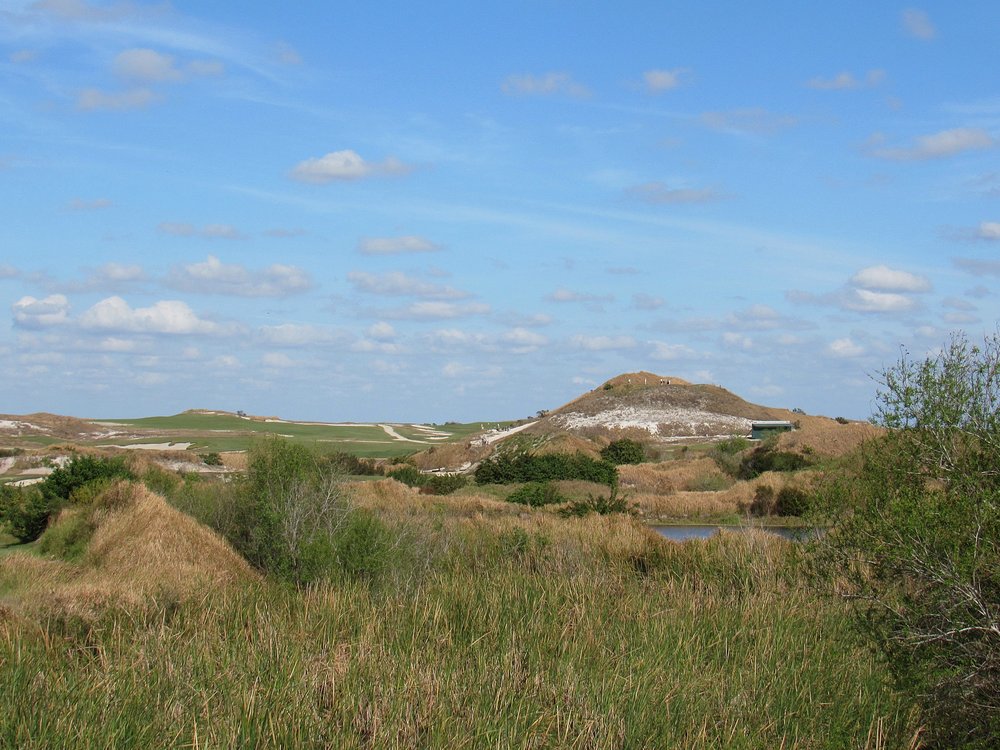Not your typical Florida golf resort: Streamsong
A trip to Streamsong, Florida's most unique golf resort


From the moment you arrive at Streamsong’s unassuming entrance sign, you realize this is not your typical Florida resort. The former phosphate mine is dominated by massive sand dunes that make you feel like you’re playing in Ireland, not swampy Central Florida.

Streamsong’s history
The resort was the brainchild of the Mosaic Company, a fertilizer giant who places an emphasis on repurposing their used land for environmental and recreational purposes. At Streamsong, the company owned 16,000 acres and decided to build a new age golf mecca – a type never seen before in Florida, where the golf courses would be rooted in the principles of naturalness, minimalism, walking and playability. The intention was to create layouts in stark contrast to the old Florida guard of challenging golf courses, routed around housing developments, filled with water hazards and incapable of being walked.
To build the dream, Mosaic turned to two of the game’s preeminent architecture firms, the duo of Bill Coore & Ben Crenshaw (Coore & Crenshaw) and Tom Doak (Renaissance Golf Design). Each set off to design their courses on the spectacular terrain simultaneously, completing both in time for the 2012 grand opening. The Coore & Crenshaw course was dubbed Streamsong Red, while Doak’s was aptly named Streamsong Blue.

Streamsong's topography is filled with natural dunes and hills
The Mosaic Company’s vision of Streamsong was slightly different from the pure golf destination Bandon Dunes that it’s often compared to. While very remote, the resort has a huge advantage of being a short drive from major Florida metro areas, Tampa (45 minutes) and Orlando (75 minutes). This geographical location has allowed it to build a hotel and spa that can lure couples and families due to the luxurious accommodations and top-notch non-golf activities such as the dining, pool, spa, fishing, archery and sport shooting.
{{content-block-streamsong-golf-resort-001}}
With the early success of the resort, plans for a third course were drawn up and in early 2015 Gil Hanse was enlisted to design Streamsong Black. The Black course is in its final construction stages and is set to open in the Fall of 2017. With Black’s completion, Streamsong will become the first golf resort to boast courses designed by the trio of Coore & Crenshaw, Tom Doak and Gil Hanse. And with 16,000 acres at their disposal, the property could be host to even more courses in the near future.
My trip to Streamsong
I had heard high praise for Streamsong, and the resort was at the top of my winter list of places to visit. I was able to fit a mid-week visit into my January Florida excursion. My plan was to drive up and play a late-morning round at Streamsong Red, spend the night, and then play an early morning round the next day at Streamsong Blue.
Getting there…
When the day finally arrived for my visit, I jumped out of bed for my early morning wake up call, and was filled with excitement and anticipation. I set out for Streamsong from the Jupiter, Florida area – a little less than three hours away. The majority of the drive was spent navigating country backroads between the east coast and central parts of the State.
The Courses
The question that dominates conversation about the resort is, which course do you like more? From what I have gathered from friends who have played them and many around the resort, the jury is still out; answers come back almost 50% Red and 50% Blue. Personally, I give a slight edge to the Red Course (Coore & Crenshaw), but feel that Doak’s Blue Course is the best of his seven designs that I have had the opportunity to play.
Each course shares the same clubhouse and is a masterpiece of routing. Doak’s Blue Course meanders through the inside part of the land while Coore & Crenshaw’s Red Course loops around the Blue. With construction of each course happening simultaneously, both construction crews deserve a lot of credit as I am certain there was a good amount of collaboration and teamwork that went into the effort.
Streamsong Red
Coore & Crenshaw’s Red Course was the first I played at Streamsong, and it was absolutely breathtaking. It was hard to fathom the massive scale and unbelievable topography on which the course was built, and the way Coore & Crenshaw laid it out. I have played hundreds of rounds in Florida, but have never seen such rugged, sandy, and hilly a terrain like it in the state.
In my eyes, the Red Course’s defining characteristic is its great variety; each hole filled with options and strategy. It has a varied collection of short and long par-4s, with tee shots that call for right to left ball flights and left to right ball flights, and green complexes that are both memorable and fair in their design. Simply put, no individual hole challenges, plays or looks similar to the last.
The Red Course begs players to attempt the heroic shot and if they pull it off the reward is a great chance at birdie or better. My round was a shining example of this, and with ball-striking on-point early, I had birdie chance after birdie chance, turning in two-under 34. However, as the barbecue off of hole 8 set in, my ball-striking fell asleep and I opened the back side with two bogeys and a double.
What put the Red Course above the Blue in my mind was the feeling it gave me walking towards the 17th green – the bittersweet feeling I get at only my favorite golf courses, knowing that the round was nearing its close. Packed with thought-provoking design, awe-inspiring vistas, and with a scale that makes your jaw drop, you never want Streamsong Red to end.
Read our full Red Course review.
{{content-block-streamsong-golf-resort-002}}
Streamsong Blue
After the thrilling Red Course, my anticipation level for Blue was off the charts. I had the first tee time of the day, and was playing with Christian Hafer, a great photographer (@hafe_life) and golf course architecture nut. Christian was able to sneak away from a family Disney Trip for the day – thank you soon-to-be Mrs. Hafer.
We both arrived at the clubhouse before sunrise, and were treated to a foggy morning that created sublime vistas on our early holes.
I have played seven Doak designs and think the Blue Course is the best of them. Much like the Red Course, its terrain and scale are remarkable. Doak is today’s master of playability, and he delivered this at Streamsong, creating a golf course that is fun for players of all abilities. Wide fairways give the average player plenty of space to swing away on their tee shots, but strategic bunker placements and devilish green complexes force great players to think and play precise shots to specific spots in order to generate birdie opportunities.
The dramatic closing stretch of 15-18 is one to remember. After the birdieable 13th and 14th, Doak ratchets up the difficulty on the 15th – an Alps template where a centerline bunker obstructs a player’s view for the second shot to the wild green complex. The 16th is a stout par 3, that plays like a quasi Redan hole, while the par-5 17th features an outstanding rendition of Tillinghast’s Great Hazard. The course finishes with a superb, long par-4 where Doak brilliantly used some of the most dramatic ground on the property.
Read our full Blue Course review
{{content-block-streamsong-golf-resort-003}}
Wrapping up
As it stands, Streamsong is the best golf destination I have had the pleasure of visiting to date. Only Bandon Dunes (which I have yet to visit) can boast an offering of golf courses that are stronger (by ranking) than Streamsong’s.
Frankly, I am astonished that neither the Red or the Blue Course has found its way into Golf Digest’s America’s 100 Greatest Courses list. For comparison sake, I found both courses to be a superior to 22nd ranked Whistling Straits. Perhaps it’s Digest’s flawed ranking system at work, but if there are 100 better courses than Streamsong’s Red and Blue, golf is in a great place.
What I feel is underappreciated about Streamsong is the amenities. As a golf crazed human who is married to a non-golfer, Streamsong’s offering of A+ lodging, a spectacular pool and spa to go along with non-golf outdoor activities make it a legitimate destination option for my wife and I. Much different when compared to a golf-only destination like Bandon Dunes.
I feel that Streamsong should be on every golf nut’s bucket list and all signs point to the resort getting better with Gil Hanse’s much anticipated Black Course opening this fall.
I am already eyeing a few fall dates to make my return.
Leave a comment or start a discussion
Engage in our content with thousands of other Fried Egg Golf Club Members
Engage in our content with thousands of other Fried Egg Golf Members
Get full access to exclusive benefits from Fried Egg Golf
- Member-only content
- Community discussions forums
- Member-only experiences and early access to events












Leave a comment or start a discussion
Lorem ipsum dolor sit amet, consectetur adipiscing elit. Suspendisse varius enim in eros elementum tristique. Duis cursus, mi quis viverra ornare, eros dolor interdum nulla, ut commodo diam libero vitae erat. Aenean faucibus nibh et justo cursus id rutrum lorem imperdiet. Nunc ut sem vitae risus tristique posuere. uis cursus, mi quis viverra ornare, eros dolor interdum nulla, ut commodo diam libero vitae erat. Aenean faucibus nibh et justo cursus id rutrum lorem imperdiet. Nunc ut sem vitae risus tristique posuere.